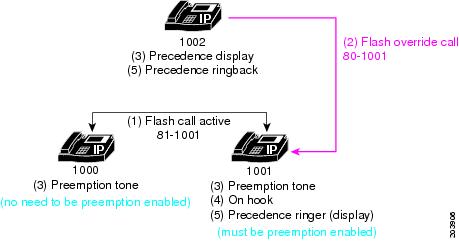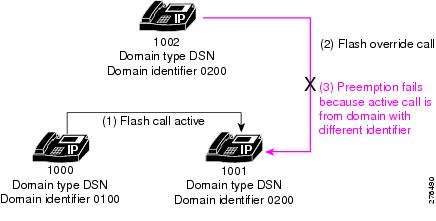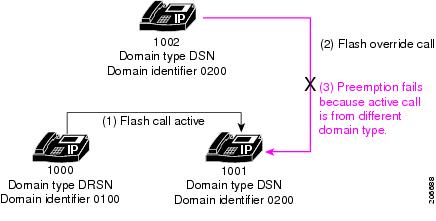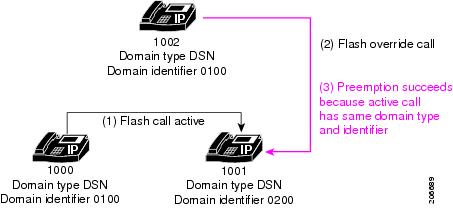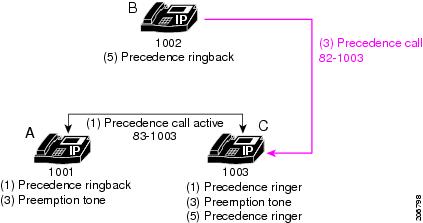

-
Cisco Unified Communications Manager Express System Administrator Guide
-
Feature Map
-
Feature History
-
Cisco Unified CME Overview
-
Before You Begin
-
Installing and Upgrading Cisco Unified CME Software
- Setting Up Basic Configuration
-
Configuring Dialing Plans
-
Configuring Localization Support
-
Configuring Transcoding Resources
-
Configuring Video Transcoding
-
Configuring Toll Fraud Prevention
-
Enabling the GUI
-
Integrating Voice Mail
-
Configuring Security
-
Adding Features
-
Configuring Automatic Line Selection
-
Configuring Barge and Privacy
-
Configuring Call Blocking
-
Configuring Call Park
-
Call Restriction Regulations
-
Configuring Call Transfer and Forwarding
-
Configuring Call-Coverage Features
-
Configuring Caller ID Blocking
-
Configuring Conferencing
-
Configuring Video Conferences
-
Configuring Voice and Video Hardware Conferencing
-
Configuring Directory Services
-
Configuring Do Not Disturb
-
Configuring Enhanced 911 Services
-
Configuring Extension Mobility
-
Configuring Fax Relay
-
Configuring Feature Access Codes
-
Configuring Forced Authorization
-
Configuring Headset Auto-Answer
-
Configuring Intercom Lines
-
Configuring Loopback Call Routing
-
Configuring MLPP
-
Configuring Music on Hold
-
Configuring Paging
-
Configuring Presence Service
-
Configuring Ring Tones
-
Configuring Single Number Reach
-
Customizing Soft Keys
-
Configuring Speed Dial
-
Configuring Video Support
-
Configuring SSL VPN Client for SCCP IP Phones
-
-
Creating Templates
-
Modifying Cisco Unified IP Phone Options
-
Configuring Interoperability with Cisco Unified CCX
-
Configuring the CTI CSTA Protocol Suite
-
Configuring SRST Fallback Mode
-
Configuring VRF Support on Cisco Unified CME
-
Configuring the XML API
-
Index
-
Table Of Contents
Automatic Call Diversion (Attendant Console)
Enabling MLPP Service Globally in Cisco Unified CME
Enabling MLPP Service on SCCP Phones
Enabling MLPP Service on Analog FXS Ports
Configuring an MLPP Service Domain for Outbound Dial Peers
Configuring MLPP
First Published: January 20, 2009Last Updated: October 7, 2009This document describes the Multilevel Precedence and Preemption (MLPP) service introduced in Cisco Unified Communications Manager Express 7.1 (Cisco Unified CME).
Finding Feature Information
Your software release may not support all the features documented in this module. For the latest feature information and caveats, see the release notes for your platform and software release. To find information about the features documented in this module, and to see a list of the releases in which each feature is supported, see the "Feature Information for MLPP" section.
Use Cisco Feature Navigator to find information about platform support and Cisco IOS, Catalyst OS, and Cisco IOS XE software image support. To access Cisco Feature Navigator, go to http://www.cisco.com/go/cfn. An account on Cisco.com is not required.
Contents
Prerequisites for MLPP
•
Cisco Unified CME 7.1
•
Cisco IOS Release 12.4(24)T
•
To use Cisco Unified CME basic automatic call distribution (B-ACD) and auto-attendant (AA) service as the MLPP attendant-console application, you must download and install the B-ACD scripts. These scripts are available from the Cisco Unified CME Software Download site at http://www.cisco.com/pcgi-bin/tablebuild.pl/ip-iostsp.
•
You can use your own audio files for the blocked precedence announcement and busy station not equipped for preemption announcement or you can use the audio files available from the Cisco Unified CME Software Download site at http://www.cisco.com/pcgi-bin/tablebuild.pl/ip-iostsp.
Information About MLPP
Multilevel Precedence and Preemption (MLPP) service allows validated users to place priority calls, and if necessary, to preempt lower-priority calls. Precedence indicates the priority level of a call. Preemption is the process of terminating a lower-precedence call so a call of higher precedence can proceed. This capability assures high-ranking personnel can communicate with critical organizations and personnel during network stress situations, such as a national emergency or degraded network situation.
To configure MLPP service in Cisco Unified CME, you should understand the following concepts:
•
Automatic Call Diversion (Attendant Console)
Precedence
Precedence indicates the priority level associated with an MLPP call. Phone users can apply a precedence level when making a call.
You define an MLPP access digit in Cisco Unified CME and assign a maximum precedence level to individual phones. Phone users request a precedence call by dialing the access code NP, where N specifies the preconfigured access digit and P specifies the requested precedence level, followed by the phone number.
Table 65 lists the precedence levels that can be associated with an MLPP call in the Defense Switched Network (DSN) domain.
Table 65 DSN Precedence Levels
0 (high)
Flash Override
1
Flash
2
Immediate
3
Priority
4 (low)
Routine
Table 66 lists the precedence levels that can be associated with an MLPP call in the Defense Red Switched Network (DRSN) domain.
Table 66 DRSN Precedence Levels
0 (high)
Flash Override Override
1
Flash Override
2
Flash
3
Immediate
4
Priority
5 (low)
Routine
A precedence call is any call with a precedence level higher than Routine. If precedence is not specifically invoked, the system processes a call using normal call processing and call forwarding.
Emergency 911 calls are automatically assigned precedence level 0.
Cisco Unified CME provides precedence indications to the source and destination of a precedence call, respectively, if either has MLPP indication enabled. For the source, this indication includes a precedence ringback tone and display of the precedence level of the call, if the device supports display. For the destination, the indication includes a precedence ringer tone and display of the precedence level of the call, if the device supports display.
Basic Precedence Call Setup
The following sequence of events occurs during the setup of a precedence call:
1.
Phone user goes off hook and dials a precedence call. The call pattern is NP-xxxx, where N is the precedence access digit, P is the precedence level for the call, and xxx is the extension or phone number of the called party.
2.
The calling party receives the precedence ringback tone and the precedence display while the call is processing.
3.
The called party receives the precedence ringer tone and the precedence display that indicates the precedence call.
Example
Party 1000 makes a precedence call to party 1001. To do so, party 1000 dials the precedence call pattern, such as 80-1001.
While the call processes, the calling party (1000) receives the precedence ringback tone and precedence display on their Cisco Unified IP Phone. After acknowledging the precedence call, the called party (1001) receives a precedence ringer tone and a precedence display on their Cisco Unified IP Phone.
Preemption
Preemption is the process of terminating an active call of lower precedence so a call of higher precedence can proceed. Preemption includes the notification and acknowledgement of preempted users and the reservation of shared resources immediately after preemption and before call termination. Preemption can take one of the following two forms:
•
User Access Preemption—This type of preemption applies to phones and other end-user devices. If a called party is busy with a lower precedence call, both the called party and the party to which it is connected, receive preemption notification and the existing call is cleared immediately.
For calls to Cisco Unified IP phones, the called party can hang up immediately to connect to the new higher precedence call, or if the called party does not hang up, Cisco Unified CME forces the phone on-hook after the configured preemption tone timer expires and connects the call.
For FXS ports, the called party must acknowledge the preemption by going on-hook, before being connected to the new higher precedence call.
•
Common Network Facility Preemption—This type of preemption applies to trunks. If all channels of a PRI trunk are busy with calls of lower precedence, a call of lower precedence is preempted to complete the higher precedence call.
Cisco Unified CME selects a trunk by first searching for an idle channel on all corresponding trunks (based on matching the called number in the dial peer).
If an idle channel is not found, Cisco Unified CME performs a preemptive-search by searching one trunk at a time for an idle channel. If no idle-channel is available on a trunk, preemption is performed on the lowest of lower-precedence calls corresponding to the trunk. If none of the calls corresponding to the trunk is of lower precedence, the next trunk is searched and so on.
SCCP phones support up to eight calls per directory number. When all lines are busy and a higher precedence MLPP call comes in, Cisco Unified CME preempts a lower precedence call on one of the channels of the directory number.
The maximum precedence level that a user can assign to an MLPP call originating from a specific phone is set using ephone templates and applied to individual phones. Calls from directory numbers that are shared by SCCP phones can have different maximum precedence levels, based on the precedence level of the phone.
Basic Preemption Call
Figure 43 shows an example of user access preemption.
Figure 43 User Access Preemption Example
In this example, the following sequence of events occurs:
1.
User 1000 places a call with precedence level 1 (flash) to user 1001, and preemption is enabled for user 1001. In this example, user 1000 dials 81-1001 to place the precedence call.
2.
User 1002 places a precedence call to user 1001 by dialing 80-1001. This call, which is of precedence level 0 (flash override), is a higher precedence call than the active precedence call.
3.
Phone 1002 receives precedence display (flash override display), and the phones that are involved in the existing lower precedence call both play preemption tones (users 1000 and 1001).
4.
To complete preemption, the parties who are involved in the lower precedence call hang up (users 1000 and 1001).
5.
The higher level precedence call is offered to user 1001, who receives a precedence ringer tone (if MLPP indication is enabled). The calling party, user 1002, receives precedence ringback.
DSN Dialing Format
Cisco Unified CME 8.0 and later releases provide complete support of the DSN dialing format, as outlined in Table 67.
Service Digit
The service digit provides information to the switch for connecting calls to government or public telephone services or networks. The services are reached through the trunk or route that is selected based on the dialed digits. Phone users request a service by dialing the access code NS, where N specifies the preconfigured access digit and S specifies the requested service, followed by the phone number.
Table 68 lists the service digits supported in Cisco Unified CME 8.0 and later versions.
Table 68 Service Digit
5
Off-net 700 services
6
Not assigned
7
DSN CONUS FTS
8
Not assigned
9
Local PSTN
In Cisco Unified CME, the route pattern is configured to supply secondary dial-tone and the remainder of the digits are collected and passed to the PSTN trunk as the called number. The digits that follow the access digit and service digit must be NANP compliant (E.164 number).
Cisco Unified CME provides secondary dial tone after the two digits and then routes the call based on the remaining collected digits (using the dial plan configuration). These services are assumed to be reached through the trunk (or route) selected based on the dialed digits (dialed after the route digits).
Route Code
The route code allows a phone user to inform the switch of special routing or termination requirements. The route code determines whether a call uses circuit-switched data or voice-grade trunking and can be used to disable echo suppressors and cancellers, and override satellite link control.
The first digit of the route code is 1. It is a required part of the dialing plan to inform the switch that the next digit, the route digit, provides network instructions for specialized routing. Phone users dial route codes in the form 1X, where X is the route digit. The supported route digits that a user can dial are 0 and 1.
Table 69 lists the route codes supported in Cisco Unified CME 8.0 and later versions:
Dialing Example
If the first digit that the user dials is the configured access digit, this indicates an access code where the next digit is either a precedence digit or a service digit. If the next digit dialed is:
•
0-4—This is a precedence call. Cisco Unified CME sets the precedence indication, stores the precedence value, and discards the digits.
•
5-9—This is a call to a particular service. Cisco Unified CME passes the call to the designated trunk, discards the digits, and plays secondary dial tone.
If the first digit that the user dials or the next digit dialed after the access code is:
•
1—This is a route code and the next digit is a route digit. The supported route digits that a user can dial are 0 and 1. Cisco Unified CME stores the route code for use later in route selection, sets a trunk-type indication, and discards the route code digits.
If the first digit that the user dials or the next digit dialed after the access code or route code is:
•
2-8—This is the first digit of the area code or switch code. Area codes and switch codes in the DSN are allocated so there is no overlap. The area code and/or switch code are used for route selection.
MLPP Service Domains
Cisco Unified CME 8.0 and later versions support MLPP service domains. A service domain consists of a group of MLPP subscribers and network resources. Calls and resources can only be preempted by higher-priority calls from MLPP subscribers within the same domain.
You can configure each device with a domain type, such as DSN or DRSN, and a domain identifier. You can assign a global MLPP domain type and identifier to the Cisco Unified CME router and assign different service domains to the individual phones registered to Cisco Unified CME through an ephone template. Calls from any phone that is not configured with a specific service domain use the global domain type and identifier.
The MLPP precedence and preemption applies only within the same domain. Only calls within the same domain can be preempted. If a call is placed between two subscribers with different MLPP service domains, Cisco Unified CME assigns the service domain of the originator to the call.
Figure 44 shows an example of preemption attempted across domains with different identifier numbers.
Figure 44 Service Domains with Different Identifiers
In the example shown in Figure 44, the following sequence of events occurs:
1.
User 1000, from service domain 0100, places a call with precedence level 1 (flash) to user 1001 in service domain 0200. The call is assigned domain number 0100 because that is the service domain of the call originator.
2.
User 1002, from domain number 0200, places a precedence call to user 1001. This call, which is of precedence level 0 (flash override), is a higher precedence call than the active precedence call.
3.
The active call is not preempted because the incoming call is from a different service domain than the active call; a call from domain 0200 cannot preempt a call from domain 0100.
In the example shown in Figure 45, the active call is not preempted because the incoming call is from a different domain type than the active call; a call from the DSN cannot preempt a call from the DRSN.
Figure 45 Service Domains with Different Domain Types
In the example shown in Figure 46, the active call is successfully preempted because the incoming call has the same domain type and identifier as the active call.
Figure 46 Service Domains with Same Type and Identifier
MLPP Indication
For basic MLPP calls with MLPP indication enabled, Cisco Unified CME instructs SCCP phones to play the precedence ringer tone and display the precedence level.
For basic MLPP calls with preemption involved and MLPP indication enabled, Cisco Unified CME instructs both parties to play the preemption tone and display the precedence level of the MLPP call on the phone.
For an MLPP call with call waiting, if MLPP indication is enabled, Cisco Unified CME instructs SCCP phones to play priority the call waiting tone instead of the regular call waiting tone.
Users receive an error tone if they attempt to make a call with a higher level of precedence than the highest precedence level that is authorized for their phone.
For example, user 1002 dials 80 to start a precedence call. Eight (8) represents the precedence access digit, and zero (0) specifies the precedence level that the user attempts to use. If this user is not authorized to make level 0 (flash override) precedence calls, the user receives an error tone.
MLPP Announcements
Users who are unable to place MLPP calls receive announcements that detail the reasons why a call was unsuccessful. Table 70 lists the supported MLPP announcements.
Automatic Call Diversion (Attendant Console)
Cisco Unified CME supports automatic diversion of all unanswered precedence calls above Routine to a designated directory number or attendant console after a selected period of time.
If automatic call diversion of MLPP calls is configured in Cisco Unified CME, it overrides the Call Forward settings on the phone for all incoming precedence calls above Routine and forwards these calls to the attendant-console application specified in the MLPP configuration. Cisco Unified CME treats MLPP calls with a precedence level of Routine as normal calls and honors the Call Forward setting configured on the phone.
How Cisco Unified CME handles forwarded MLPP calls depends on the following Call Forward options:
•
Call Forward All (CFA)—Precedence calls are routed to the target number of the attendant console immediately. The CFA target is not used for MLPP calls.
•
Call Forward Busy (CFB)—Precedence calls are forwarded to the configured CFB destination. If the CFB destination is Voice Mail or an off-net endpoint, the call is forwarded to the target number of the attendant-console service.
•
Call Forward No Answer (CFNA)—Precedence calls are forwarded to the configured CFNA destination. If the CFNA destination does not answer before the CFNA timer expires, or it is voice mail or an off-net endpoint, the call is forwarded to the target number of the attendant-console service.
Calls diverted to the attendant console are indicated by a visual signal and placed in the queue for attendant service by precedence and time interval. The call with the highest precedence and longest holding time is answered first. Attendant Queue Announcement is played to calls waiting in the queue for attendant service. Call distribution is performed to reduce excessive waiting time and each attendant position operates from a common queue. Cisco Unified CME supports attendant console service for MLPP using Basic Automatic Call Distribution (B-ACD) and auto-attendant (AA) service.
How to Configure MLPP
This section contains the following tasks.
•
Enabling MLPP Service Globally in Cisco Unified CME
•
Enabling MLPP Service on SCCP Phones
•
Enabling MLPP Service on Analog FXS Ports
•
Configuring an MLPP Service Domain for Outbound Dial Peers
Enabling MLPP Service Globally in Cisco Unified CME
To enable MLPP globally in Cisco Unified CME, perform the following steps. This task covers the basic steps necessary to enable MLPP on the router.
Prerequisites
Trunks must belong to a trunk group and have preemption enabled. For configuration information, see "Enabling Preemption on the Trunk Group" in Integrating Data and Voice Services for ISDN PRI Interfaces on Multiservice Access Routers.
Restrictions
•
SIP phones are not supported.
•
Cisco Unified IP Phone 6900 Series phones are not supported.
•
Cisco Unified CME in SRST Fallback mode is not supported.
•
Supports only ISDN PRI E1 and T1interfaces.
•
Supports MLPP service within the local Cisco Unified CME router only.
•
Cisco Unified CME 7.1 supports only Basic Calls, Call Forward, Call Hold and Resume, Consultative Call-Transfer, and Call Waiting. Blind Transfer is not supported.
•
Cisco Unified CME 8.0 and later versions support Three-Party Ad Hoc Conferencing and Call Pickup.
•
Call Park Retrieval based on precedence level is not supported; Cisco Unified CME must be configured to accept only one call per park slot.
SUMMARY STEPS
1.
enable
2.
configure terminal
3.
voice mlpp
4.
access-digit digit
5.
bnea audio-url
6.
bpa audio-url
7.
upa audio-url
8.
service-domain {drsn | dsn} identifier domain-number
9.
end
DETAILED STEPS
Examples
The following example shows MLPP enabled on the Cisco Unified CME router.
voice mlpp
access-digit 8
bpa flash:bpa.au
bnea flash:bnea.au
upa flash:upa.au
service-domain dsn identifier 000010
Enabling MLPP Service on SCCP Phones
To enable MLPP capabilities on an SCCP phone, perform the following steps.
Prerequisites
MLPP must be enabled globally on the Cisco Unified CME router. See the "Enabling MLPP Service Globally in Cisco Unified CME" section.
Restrictions
The mlpp max-precedence command is not supported in Cisco Unified CME 8.0 and later versions; it is replaced by the mlpp service-domain command.
SUMMARY STEPS
1.
enable
2.
configure terminal
3.
ephone-template template-tag
4.
mlpp service-domain {drsn | dsn} identifier domain-number max-precedence level
5.
mlpp preemption
6.
mlpp indication
7.
exit
8.
ephone phone-tag
9.
ephone-template template-tag
10.
restart
11.
end
DETAILED STEPS
Examples
The following example shows a basic configuration for three phones, all using template 1 with MLPP defined. Figure 47 shows an example of a precedence call using this configuration.
voice mlpp
access-digit 8
bpa flash:BPA.au
bnea flash:BNEA.au
upa flash:UPA.au
ephone-template 1
mlpp service-domain dsn identifier 000000 max-precedence 0
!Configures MLPP domain as DSN, identifier as 000000, and max-precedence set to 0
ephone-dn 1
number 1001
ephone-dn 2
number 1002
ephone-dn 3 dual-line
number 1003
huntstop channel
ephone 1
description Phone-A
mac-address 1111.2222.0001
button 1:1
ephone-template 1
! MLPP configuration inherited from ephone-template 1
ephone 2
description Phone-B
mac-address 1111.2222.0002
button 1:2
ephone-template 1
ephone-3
description Phone-C
mac-address 1111.2222.0003
button 1:3
ephone-template 1
Note
The huntstop channel command must be configured on dual-line and octo-line directory numbers to preempt a call on those types of lines. Otherwise the dual-line or octo-line receives Call Waiting indication and the call is not preempted.
Figure 47 Preemption Call Example
In this example, the following sequence of events occurs:
1.
Phone A places a precedence call to Phone C by dialing 831003 (access digit 8 + precedence level 3 + destination number 1003).
Phone C hears the precedence ringer tone and Phone A hears the precedence ringback.
2.
Phone C answers the call.
3.
Phone B places a higher precedence call to Phone C by dialing 821003. Phone A and Phone C both hear the preemption tone for the duration of the preemption tone timer command (default value is three seconds).
4.
Phone A is preempted after three seconds.
5.
Phone C starts ringing (precedence ringer) and Phone B hears the precedence ringback.
6.
Phone C answers the call.
Enabling MLPP Service on Analog FXS Ports
To enable MLPP capabilities for an analog FXS phone, perform the following steps.
Prerequisites
MLPP must be enabled globally on the Cisco Unified CME router. See the "Enabling MLPP Service Globally in Cisco Unified CME" section.
SUMMARY STEPS
1.
enable
2.
configure terminal
3.
voice-port port
4.
mlpp service-domain {drsn | dsn} identifier domain-number max-precedence level
5.
mlpp preemption
6.
mlpp indication
7.
end
DETAILED STEPS
Examples
The following example shows that the analog FXS phone connected to voice port 0/1/0 can make MLPP calls with the highest precedence and its calls cannot be preempted.
voice-port 0/1/0
mlpp service-domain dsn identifier 000020 max-precedence 0
no mlpp preemption
station-id name uut1-fxs1
caller-id enable
Configuring an MLPP Service Domain for Outbound Dial Peers
To assign a service domain to MLPP calls that must leave the Cisco Unified CME router through the trunk, perform the following steps for the corresponding dial peer.
SUMMARY STEPS
1.
enable
2.
configure terminal
3.
voice class mlpp tag
4.
service-domain {drsn | dsn}
5.
exit
6.
dial-peer voice tag {pots | voip}
7.
voice-class mlpp tag
8.
exit
DETAILED STEPS
Examples
The following example shows an MLPP voice class defined for the DSN service domain. This voice class is assigned to a POTS dial peer so that calls leaving port 0/1/0 use the DSN protocol.
voice class mlpp 1
service-domain dsn
!
!
dial-peer voice 1011 pots
destination-pattern 19101
voice-class mlpp 1
port 0/1/0
Configuring MLPP Options
To configure optional MLPP features or modify default settings, perform the following steps.
SUMMARY STEPS
1.
enable
2.
configure terminal
3.
voice mlpp
4.
preemption trunkgroup
5.
preemption user
6.
preemption tone timer seconds
7.
preemption reserve timer seconds
8.
service-domain midcall-mismatch {method1 | method2 | method3 | method4}
9.
service-digit
10.
route-code
11.
attendant-console number redirect-timer seconds
12.
ica audio-url
13.
loc2 audio-url
14.
vca audio-url voice-class cause-code tag
15.
end
DETAILED STEPS
Examples
The following example shows an MLPP configuration with optional parameters.
voice mlpp
preemption trunkgroup
preemption user
preemption tone timer 15
preemption reserve timer 10
access-digit 8
attendant-console 8100 redirect-timer 10
service-digit
route-code
bpa flash:bpa.au
bnea flash:bnea.au
upa flash:upa.au
ica flash:ica.au
loc2 flash:loc2.au
vca flash:vca.au voice-class cause-code 29
service-domain midcall-mismatch method2
service-domain dsn identifier 000010
Troubleshooting MLPP Service
To troubleshoot MLPP services, perform the following steps.
SUMMARY STEPS
1.
enable
2.
debug ephone mlpp
3.
debug voice mlpp
4.
end
DETAILED STEPS
Additional References
The following sections provide references related to Cisco Unified CME.
Related Documents
Cisco Unified CME configuration
•
Cisco Unified Communications Manager Express System Administrator Guide
•
Cisco Unified Communications Manager Express Command Reference
Cisco Unified CME network design
•
Cisco Unified CallManager Express Solution Reference Network Design Guide
Cisco IOS voice configuration
•
Cisco IOS Voice Configuration Library
Phone documentation for Cisco Unified CME
Standards
No new or modified standards are supported by this feature, and support for existing standards has not been modified by this feature.
—
MIBs
RFCs
No new or modified RFCs are supported by this feature, and support for existing RFCs has not been modified by this feature.
—
Technical Assistance
Feature Information for MLPP
Table 71 lists the release history for this feature.
Not all commands may be available in your Cisco IOS software release. For release information about a specific command, see the command reference documentation.
Use Cisco Feature Navigator to find information about platform support and software image support. Cisco Feature Navigator enables you to determine which Cisco IOS software images support a specific software release, feature set, or platform. To access Cisco Feature Navigator, go to http://www.cisco.com/go/cfn. An account on Cisco.com is not required.
Note
Table 71 lists only the Cisco IOS software release that introduced support for a given feature in a given Cisco IOS software release train. Unless noted otherwise, subsequent releases of that Cisco IOS software release train also support that feature.

 Feedback
Feedback